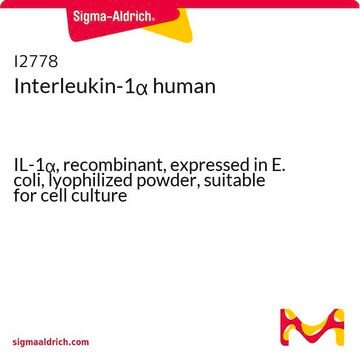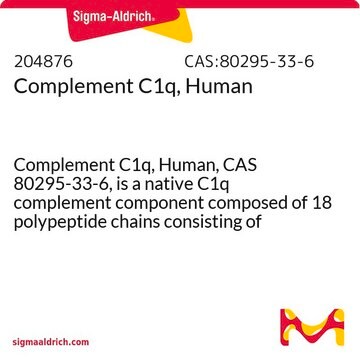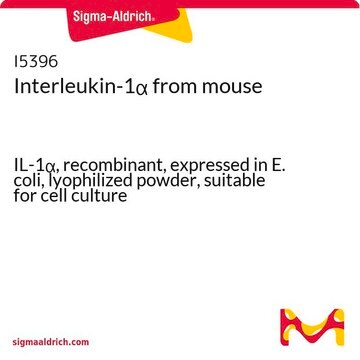I3901
Interleukin-1α from rat
IL-1α, recombinant, expressed in E. coli, lyophilized powder, suitable for cell culture
Synonyme(s) :
rIL-1α, IL-1α, Lymphocyte activating factor
About This Item
Produits recommandés
Source biologique
rat
Niveau de qualité
Produit recombinant
expressed in E. coli
Pureté
≥97% (SDS-PAGE)
Forme
lyophilized powder
Puissance
1-10 pg/mL EC50
Qualité
endotoxin tested
Poids mol.
~18 kDa
Conditionnement
pkg of 5 μg
Technique(s)
cell culture | mammalian: suitable
Impuretés
≤0.1 EU/μg
Numéro d'accès UniProt
Température de stockage
−20°C
Informations sur le gène
rat ... Il1a(24493)
Actions biochimiques/physiologiques
Forme physique
Remarque sur l'analyse
Code de la classe de stockage
11 - Combustible Solids
Classe de danger pour l'eau (WGK)
WGK 3
Point d'éclair (°F)
Not applicable
Point d'éclair (°C)
Not applicable
Équipement de protection individuelle
Eyeshields, Gloves, type N95 (US)
Certificats d'analyse (COA)
Recherchez un Certificats d'analyse (COA) en saisissant le numéro de lot du produit. Les numéros de lot figurent sur l'étiquette du produit après les mots "Lot" ou "Batch".
Déjà en possession de ce produit ?
Retrouvez la documentation relative aux produits que vous avez récemment achetés dans la Bibliothèque de documents.
Articles
Interleukins, released from leukocytes, include IL-1β playing crucial roles in inflammation, immune responses, and anti-tumor immunity.
Notre équipe de scientifiques dispose d'une expérience dans tous les secteurs de la recherche, notamment en sciences de la vie, science des matériaux, synthèse chimique, chromatographie, analyse et dans de nombreux autres domaines..
Contacter notre Service technique







